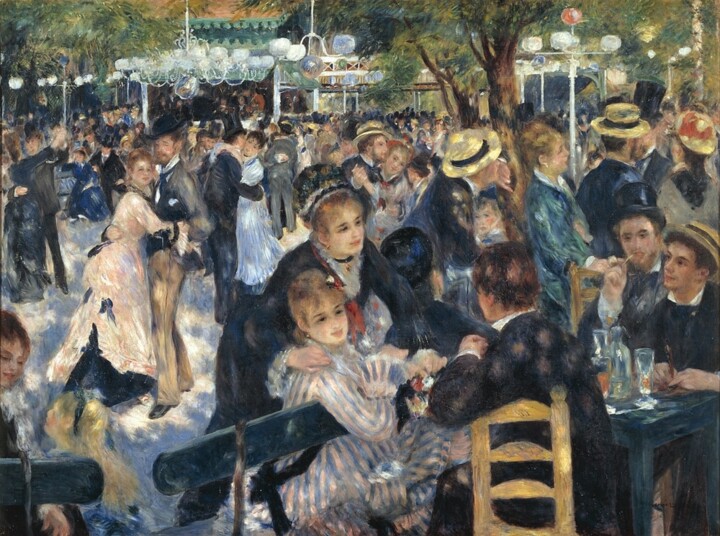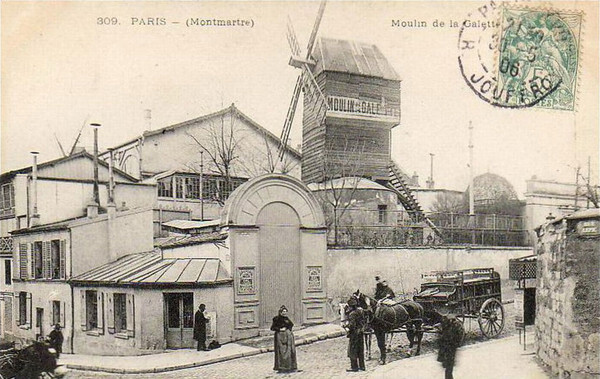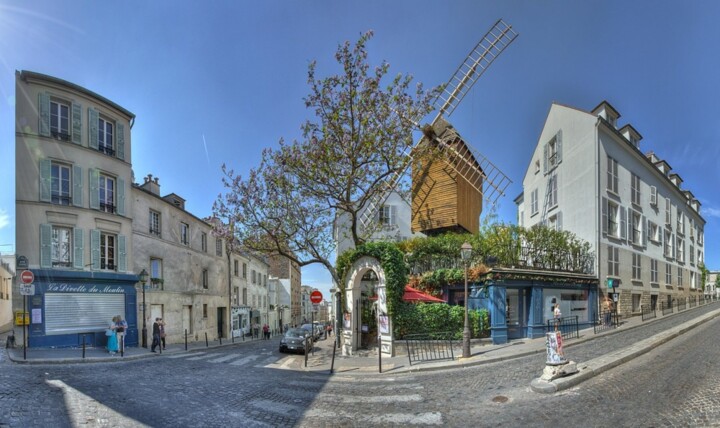 Bal du Moulin de la Galette, Auguste Renoir, oil painting, 131 × 175 cm, 1876
Bal du Moulin de la Galette, Auguste Renoir, oil painting, 131 × 175 cm, 1876
"Le Bal du moulin de la Galette" is a pictorial work produced in 1876 by the French impressionist painter Auguste Renoir . This oil on canvas, measuring 131 × 175 cm, is currently on display at the Musée d'Orsay in Paris, where it was acquired in 1894 by the bequest of the painter and collector Gustave Caillebotte.
Description of the work
The scene takes place in the open air, as required by the Impressionists, on a sunny Sunday afternoon at the Moulin de la Galette in Montmartre. The people present in the scene are friends of the painter: models, painters, regulars of the place, among whom we recognize the writer Georges Rivière, the painters Norbert Gœneutte and Franc-Lamy seated in the foreground, as well as a woman named Estelle seated on the bench, and Frédéric Samuel Cordey.
Renoir thus represents on his canvas a joyful crowd of people from all walks of life, sharing a good time. Some dance on the left, others chat on the right, smoke and drink.
We can distinguish three planes: in the foreground, we find the people seated discussing, in the second plane, the dancers, and in the third plane, the buildings where we can see the orchestra.
Instead of using sharpness in the foreground followed gradually by blur, as most painters do, Renoir chose to apply blur everywhere. The only indication of depth is by the size of the figures represented. He decides to represent this scene in a bluish atmosphere, dotted with patches of light distributed unevenly, as if they were crossing the foliage of the trees to reach the crowd. It is thanks to light that Renoir brings out his characters.
Techniques used for this painting
Renoir was known for his light and fluid touch painting technique. He applied the paint with quick, delicate brushstrokes, creating a sense of movement and spontaneity in the composition. Contrary to the traditional practice of making objects sharp in the foreground and creating a gradual blur towards the background, Renoir chose to apply a soft focus throughout the painting. This gives the work a soft atmosphere and suggests a fleeting impression of the bustling scene.
Renoir used light in a subtle way to highlight certain elements of the scene. Spots of light pass through the trees and illuminate the figures, creating contrasts and drawing attention to specific areas of the painting. Renoir's color palette is characterized by the use of bright hues and pastel tones. These colors give a cheerful and festive atmosphere to the painting, enhancing the impression of conviviality and entertainment.
History of the work
Throughout the process of creating the Moulin de la Galette, Renoir settled in an old hut located in rue Cortot.
This work was presented for the first time during the third Impressionist exhibition in April 1877. Georges Rivière, art critic, wrote about it: "It is a true historical testimony, a precious monument representing Parisian life with rigorous accuracy. »
In 1879, Gustave Caillebotte, painter and friend of Renoir, bought the painting, which he then bequeathed to the French state in 1894. Today, the painting is kept in the Musée d'Orsay, in room 32, at the top level.
There are also other versions of this painting. Renoir created a second, smaller version, measuring 78 × 114 cm, which is in a private collection belonging to the Whitney family. In 1990, this version was sold to a wealthy Japanese industrialist for the sum of 78 million dollars. This collector is also the owner of Vincent van Gogh's Portrait of Doctor Gachet with a Foxglove Branch.
 Galette mill in Paris (France) in 1905
Galette mill in Paris (France) in 1905
Why is this an important work?
Contribution to Impressionism: This painting is one of the most iconic works of the Impressionist movement. It perfectly represents the characteristics of this artistic movement, such as the capture of light in the open air, the use of bright colors, the representation of moments of daily life and the technique of light touch.
Testimony of Parisian life: "Le Bal du moulin de la Galette" bears witness to the social and cultural life of Paris at the time. Renoir depicted a lively and festive scene in a popular place of entertainment, where people from different social backgrounds gathered to dance, have fun and enjoy each other's company.
Realism of the characters: Renoir captured with realism the diversity of the characters present in the scene. We recognize friends of the painter, models, artists and regulars of the place. This authentic depiction of society reflects the Impressionists' interest in everyday life and human relationships.
Artistic innovation: Renoir's use of light, blur and rapid brushstrokes was innovative at the time. He created a dynamic and immersive atmosphere, giving a sense of movement and spontaneity to the painting.
Influence on later art: "Le Bal du moulin de la Galette" had a significant influence on later generations of artists. His impressionist style paved the way for new artistic experimentation and contributed to the recognition of this movement as a revolutionary approach in the history of art.
6 incongruous things about the work
Depiction of characters: Although the characters depicted in the painting are described as friends of Renoir, it is unlikely that they were all present at the same event at the Moulin de la Galette. Renoir grouped people from different occasions and times into a single scene, which creates a certain temporal inconsistency.
Absence of musicians: Although the orchestra can be seen in the third plane of the painting, the musicians themselves are absent. One wonders where the artists are who produce the music that animates the ball.
The size of the figures: The scale of the figures in the painting is somewhat disconcerting. Some figures, such as the dancing couple on the left, appear disproportionate to the other figures in the scene, creating visual distortion.
The Pervasiveness of Spots of Light: Although light filtering through the trees and creating patches of light is a feature of the painting, their uneven distribution and excessive presence in certain areas can seem somewhat unrealistic.
Social Diversity: The painting depicts a crowd of people from different social backgrounds, dancing, chatting and having fun together. However, it is unlikely that such social diversity would actually be found at a ball of the time, where social classes were generally separated.
The Carefree Atmosphere: Despite the realism and liveliness of the scene, the lack of clues to the darker aspects of Parisian life at the time, such as poverty or inequality, can feel a bit idealized and disconnected of the social reality of the time.
 The galette auhourd'hui mill in Paris © Giorgio Galeotti via wikipedia
The galette auhourd'hui mill in Paris © Giorgio Galeotti via wikipedia
Influences of the Bal du moulin de la galette in contemporary culture
Auguste Renoir's Le Bal du moulin de la Galette has had a significant influence on contemporary culture, particularly in the fields of art, music, fashion and advertising. Here are some concrete examples:
Artistic references: Many contemporary artists have been inspired by the Bal du moulin de la Galette to create their own works. We can quote the photographer Martin Parr who recreated the scene of the ball with contemporary characters in his series "Small World". Additionally, contemporary artists like David LaChapelle have incorporated visual references to this painting into their work.
Cinematographic adaptations: The influence of Bal du moulin de la Galette has spread to the cinema. For example, in the movie "Moulin Rouge!" by Baz Luhrmann, we can find references to the festive atmosphere and the dance present in Renoir's painting.
Scenography and events: Contemporary events and parties have been inspired by the aesthetics of the Bal du moulin de la Galette. For example, theme nights recreated the ambiance of an open-air ball, with sets, costumes and an atmosphere reminiscent of Renoir's painting.
Fashion and Advertising: The colorful and fashionable outfits of the characters in the painting influenced the field of fashion. Fashion designers have drawn on the patterns, colors and style of this period to design contemporary collections. Additionally, advertisements have used the aesthetics of the ball and the cheerful mood of the painting to promote various products and events.
Interior decorations: The visual elements of Bal du moulin de la Galette were used as inspiration for the interior decoration. Floral patterns, bright colors and festive atmosphere have been taken up in contemporary designs, especially for textiles, wallpapers and accessories.
References in music: Painting has also influenced the world of music. For example, Bruno Mars' song "Grenade" references the ball scene and uses lyrics evocative of love and celebration.
Major exhibitions
Le Bal du moulin de la Galette by Auguste Renoir has been featured in several major exhibitions around the world. Here are some of the notable exhibitions where this famous work has been exhibited:
1877 Impressionist Exhibition: The painting was first exhibited at the Third Impressionist Exhibition, held in April 1877 in Paris. This event played a key role in the recognition of the Impressionist movement and allowed the public to discover innovative works, including Le Bal du moulin de la Galette by Renoir.
Musée d'Orsay, Paris: Since its acquisition by the French state in 1894, the painting has been on display at the Musée d'Orsay in Paris. This renowned museum houses an extensive collection of 19th-century art, including many major Impressionist works. The Bal du Moulin de la Galette is presented to the public in this prestigious setting, where visitors can admire it alongside other masterpieces of Impressionism.
International exhibitions: The Bal du moulin de la Galette has also been loaned to various international exhibitions. For example, it was presented during the Renoir exhibition at the Royal Academy of Arts in London in 1985. These special exhibitions allowed a wide audience to discover and appreciate this emblematic work.


 Selena Mattei
Selena Mattei